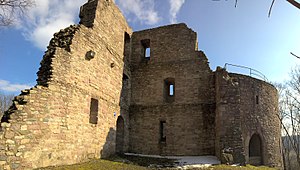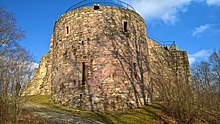Steckelberg Castle
| Steckelberg Castle | ||
|---|---|---|
| Creation time : | 1131 (previous castle) 1387/1388 (current castle ruins) |
|
| Castle type : | Hilltop castle | |
| Conservation status: | ruin | |
| Standing position : | Nobles | |
| Place: | Schlüchtern -Ramholz | |
| Geographical location | 50 ° 20 '13 " N , 9 ° 37' 13" E | |
|
|
||
The Steckelberg Castle is the ruins of a hilltop castle in Ramholz , a district of osthessischen town Schlüchtern in Germany .
location
The ruins of the former castle complex are located east of Vollmerz and northeast of Ramholz on a hilltop of a promontory of the Steckelberg of the same name.
history
The name of the castle goes back to the Middle High German term for "steep mountain" ( Stechelnberc ). As a Reichsburg , the fortifications served to protect the traffic routes that led through the Bergwinkel. The wine route running from Fulda to Franconia led here over the ridge of the Breiten First ; this important north-south connection, which is already known to old road research from Carolingian times , affects the fortifications in their course between Veitsteinbach and Sterbfritz .
From 1131 to 1391 the Lords of Steckelberg had their headquarters on a nearby predecessor complex. This old Steckelberg castle was located northeast of today's ruin on a foothill of the Breiten First, which is now known as Alteburgberg or Nickus . The baron family Hermann von Steckelberg is mentioned around 1167. Between 1240 and 1276, the castle must have been briefly owned by the Würzburg diocese. In 1274 Bishop Berthold II pledged the castle to Count Reinhard I (Hanau) , whom he needed as an ally. In 1276 it was occupied illegally and used as a robber baron castle. The castle was in 1276 on the orders of King Rudolf I. destroyed. On October 14, 1276, he passed the judgment that the Steckelburg should be demolished and never be rebuilt without the imperial permission . Supposedly she posed a threat to the peace in the country ; However, this measure probably served more to round off the property of the governor and confidante of the king, the Count of Hanau , in this area. However, the administration and usage rights remain with the gentlemen von Steckelberg.
There is no more detailed knowledge of the history of the origins of the old Steckelberg Castle . However, it is considered certain that this was not the oldest fortification at this location either: in 1969 the remains of an approx. 0.38 hectare ring wall system were discovered in the immediate vicinity , which is dated to the early Middle Ages .
In the middle of the 14th century , the male line of the von Steckelberg family died out; possessions and hereditary fiefs fell to the daughters and their husbands, among them the Frowin von Hutten († 1377). Among other things, he inherits fields and meadows on the Steckelberg. Frowin's son Ulrich von Hutten († 1423) uses this starting position to fortify the castle hill again in 1388 and to build Steckelberg Castle at its current location. In formal legal circumvention of the royal ban, this fortification is being built, offset by a few hundred meters, above the previous building that was destroyed in 1276. This factual breach of law remains unpunished, as Ulrich transfers the ownership rights to the castle back to the Würzburg bishop and thus removes it from the control of the actual rulers, namely the Counts of Hanau .
After Ulrich's death, the entire family was enfeoffed with Steckelberg Castle. In 1452 Lorenz von Hutten († 1498) concluded a truce with the other heirs , in which, in addition to the amount of joint maintenance payments and the supply of the castle in the event of siege, it was also determined who was allowed to use the castle as a basis for feuds under what conditions . Despite the comparison, there was a dispute between Hutten-Steckelberg and their liege lord Würzburg from 1452 when they wanted to take in 32 outside heirs. In 1458 the castle was therefore besieged and finally conquered by Bishop Johann. However, after a settlement, he gave the castle back as early as 1459. The partially destroyed castle will be rebuilt or renewed and inhabited again.
Ulrich von Hutten was born here on April 21, 1488 . In a letter to Willibald Pirckheimer from 1518, he vividly - but probably exaggerated - the conditions at his home castle.
In 1525 insurgent farmers overran the Steckelberg, but fail. From the middle of the 16th century , the neighboring seat in the village of Ramholz, located at the foot of the castle hill, became more important for the owners. The Steckelberg remained as a fortification until the late 17th century , as the pledges in the Thirty Years' War make clear. Philipp Daniel von Hutten († 1687) is the last noble resident of the castle. A hand drawing also dates from this time, showing the building in its last phase of expansion, which has probably not been significantly changed since 1509. Around 1700 the castle was already used as a quarry. It can be assumed that it became uninhabitable during the Thirty Years' War .
In 1883, Baron Hugo von Stumm bought the ruins and saved them from further deterioration. He himself moved into the Huttian estate in Ramholz and expanded it into a spacious palace complex in the style of historicism (→ main article: Ramholz Palace ).
In 2004, the current owner had the east wall of the castle renovated and the moat exposed. In early 2008 the ruin was closed because parts of the north wall had collapsed; on May 26, 2013, the newly renovated Steckelberg castle ruins were officially reopened.
investment
The ruins of the former castle have the remains of a rectangular enclosure wall with a gun turret at the entrance to the west (modern built-in chimney), a three-story kemenaten building to the northwest and a cellar. Large parts of the walls collapsed in mid-2007.
Regarding the so-called battery tower : The thesis that Ulrich's father of the same name had the mighty powder or gun tower built in 1509 that controls access to the castle has always been uncritically copied . The masonry and loopholes clearly show that the tower was built in 1388/1389. The aforementioned door with the year 1509 is used as a secondary feature. This year marks a renovation of the now useless tower rather than another residential building, which is proven by the design of the door, the chimney and other details.
gallery
Memorial plaque to Ulrich von Hutten
literature
- Dehio , Ernst Gall: manual of the German art monuments . Southern Hesse , Berlin 1950.
- Fritz-Rudolf Herrmann : Steckelberg ruins and their predecessors near Schlüchtern-Vollmerz, Main-Kinzig district. Guide sheet to the early medieval ramparts, Altenburg and Steckelberg Castle via Ramholz. (Archaeological Monuments in Hessen, Issue 105.) State Office for Monument Preservation Hessen, Wiesbaden, 1993, ISBN 3-89822-105-9
- Elvira Klein: The excursion to castles and palaces in Hesse and the neighborhood , Frankfurt am Main 1996.
- Rudolf Knappe: Medieval castles in Hessen. 800 castles, castle ruins and fortifications. 3. Edition. Wartberg-Verlag, Gudensberg-Gleichen 2000, ISBN 3-86134-228-6 .
- Hans Körner: The von Hutten family. Genealogy and possessions until the end of the Old Kingdom. In: Peter Laub and Ludwig Steinfeld (edit.): Ulrich von Hutten: Knight - Humanist - Publicist (1488–1523). Catalog for the exhibition of the state of Hesse on the occasion of the 500th birthday . Kassel 1988, pp. 143-153.
- Jörg Lindenthal: Cultural Discoveries. Archaeological monuments in Hessen. Jenior, Kassel 2004, pp. 185 f., ISBN 3-934377-73-4
Web links
- Search for Burg Steckelberg in the SPK digital portal of the Prussian Cultural Heritage Foundation
- Steckelberg Castle on burgenwelt.org
- City of Schlüchtern: ruins of Castle Steckelberg
- Wolfgang Braun: Reconstruction drawing in the medieval state
Individual evidence
- ↑ Landau, Georg: Contributions to the history of the old military and trade routes , Bärenreiter Verlag, Kassel and Basel, reprint 1958, page 85
- ^ Arnd, Carl: History of the Province of Hanau and the Lower Main Area , Verlag Friedrich König, Hanau 1858, page 333
- ↑ Digital Archive Marburg: Excerpt from Ulrich von Hutten's (1488-1523) letter to the Nuremberg patrician Willibald Pirckheimer (1470-1530) about life in a castle, October 25, 1518
- ↑ Closure of the Steckelberg ruins. (PDF; 114 kB) (No longer available online.) In: Official Journal for the City of Schlüchtern, Volume 20, Number February 9th, 29th, 2008, archived from the original on March 8th, 2014 ; Retrieved March 11, 2013 . Info: The archive link was inserted automatically and has not yet been checked. Please check the original and archive link according to the instructions and then remove this notice.
- ^ Reopening of the Steckelberg castle ruins on May 26, 2013. (No longer available online.) In: Schlüchtern.de. Archived from the original on March 8, 2014 ; Retrieved June 13, 2013 . Info: The archive link was inserted automatically and has not yet been checked. Please check the original and archive link according to the instructions and then remove this notice.
- ^ Castle Steckelberg near Ramholz, Hessische Rhön The incorrect dating of the "battery tower" ( memento from February 23, 2014 in the Internet Archive ) by Joachim Dittrich, 2006/2009












